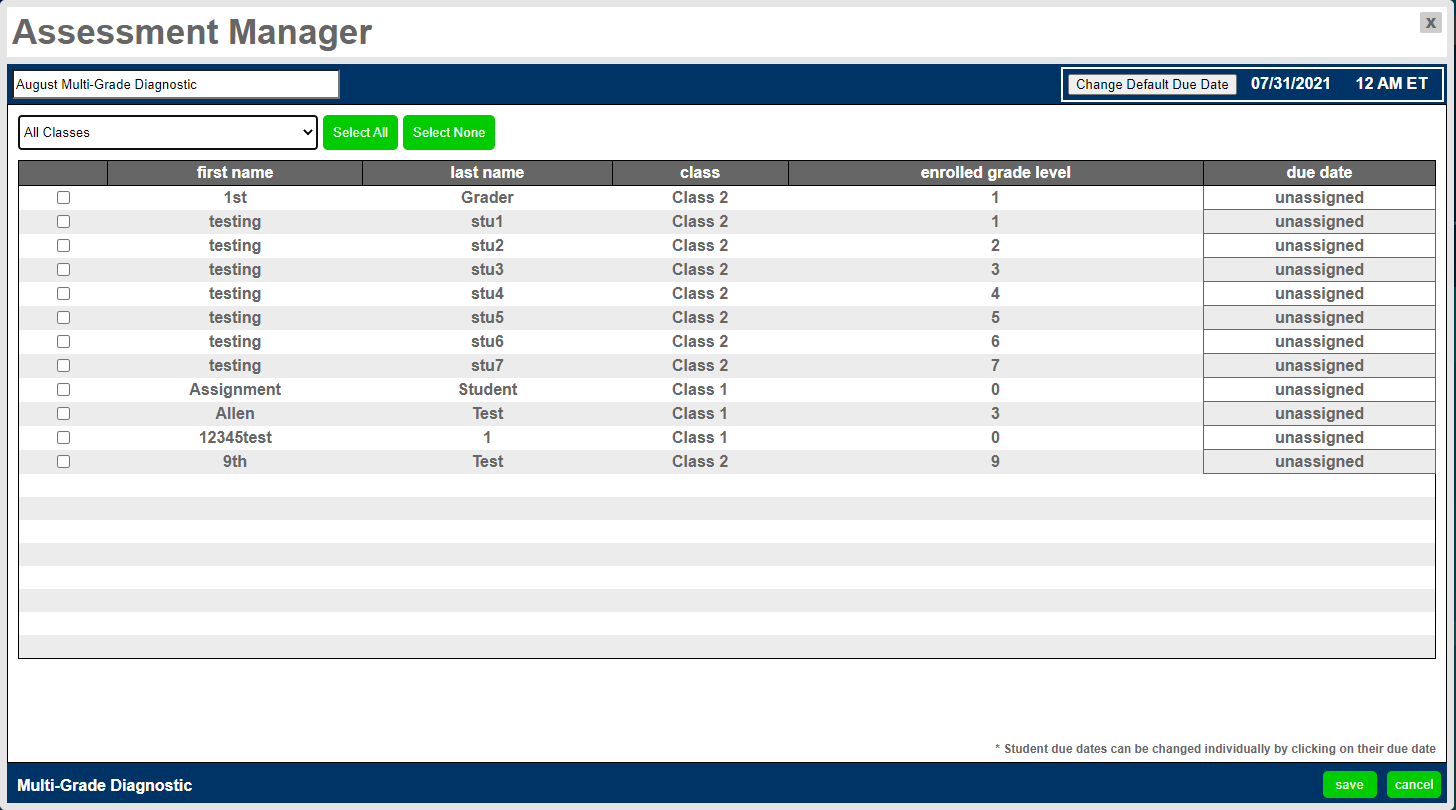Both the Benchmark and Multi Grade Diagnostic include questions at grade level. The difference is, a Benchmark includes only grade level topics while a Multi Grade Diagnostic has questions from multiple grades. For example, a 4th grader in a Benchmark only sees 4th grade math questions. A 4th grader in a Multi Grade Diagnostic sees a random mix of questions from 4th, 3rd, 2nd, 1st and Kindergarten, with the most questions from 4th and the fewest, perhaps only one or two, from 1st and K. Both test types, the Benchmark and Multi Grade Diagnostic are designed to be completed in one 50-minute class period. The test has a two hour time limit and remains open until the expiration date you set. This means students must answer all questions on the test before it is evaluated and reporting is available. The Summary report for each test was designed to identify any and all students who might be "not assigned," "not started," or "in progress."
For both the Benchmark and the Multi Grade Diagnostic, we recommend assigning two to four times, from the beginning to end of the school year.
For which assessment to assign, we suggest just picking one and then being consistent with that test type throughout the school year. If you'd like to test students at and below grade level, assign the Multi-Grade Diagnostics. If you'd like to test at grade level only, assign Benchmarks. With either, you'll get a plethora of powerful reporting tools from the district to student levels.
With district admins, school admins, and teachers all having the ability to assign Assessments, it is important to clarify who should assign Assessments, and which Assessments should be assigned.
Remember that district or school administrators assign Benchmarks or Multi-Grade Diagnostics. Teachers can assign the same tests with different names and reporting. Teachers assign Grade Level Tests instead of Benchmarks, and Multi-Grade Level Tests instead of Multi-Grade Diagnostics. These are separated by name so teachers can freely assigned them without impacting the district or school reporting.
Our recommendation is to assign Assessments at the highest level possible. If iLearn is being implemented across your district, we would recommend having a district administrator assigning the Assessments. This way, the Assessment data is carried across schools and is consistent. For example, if a student transfers from one school to another in the same district and Assessments assigned were at the district level, the student's data will easily transfer from their old school to the new school. If iLearn is being implemented only at the school level, then we recommend assigning Assessments as a school administrator.
Progress Monitoring can be great, if you have time to use it correctly. Progress Monitoring allows educators to assign any short-form grade level test to any student at any time. Ideally, Progress Monitoring assessments would be assigned every 3-4 weeks throughout the school year, and would assign students the grade level test matching the grade level content the student is currently learning in iLearn Math. For example, if a 5th grade student is currently in 2nd grade content in iLearn Math, we would recommend assigning a 2nd grade Progress Monitoring assessment to that student every few weeks, until the student moves beyond 2nd grade content. When the student moves into 3rd grade content, we suggest assigning both the 2nd grade and the 3rd grade Progress Monitoring Assessment to serve as a final 2nd grade test and initial 3rd grade test.
The Progress Monitoring assessments, used correctly, can give educators excellent data to chart a student's progress back to grade level across the school year - which is great for documenting progress and growth.
We recommend teachers create and assign a Progress Monitoring assessment at least once a month (school or district admins can assign Progress Monitoring as well, but ideally this is done by teachers). When using Progress Monitoring, choose "iLearn Math Location Grade Level" from the "Set Assessment Grade Level To:" drop down menu (as shown in the picture below). This will ensure that all students in the class receive the grade level test appropriate for the grade level content they are currently learning. Note: Since students will be advancing throughout the school year, avoid pre-assigning all Progress Monitoring tests for the school year. This is because it is impossible to know ahead of time at what level a student will be learning and which test will be appropriate for a particular test-taking window months in the future. To avoid this, assign the Progress Monitoring tests a day or two ahead of their test-taking window if possible.
